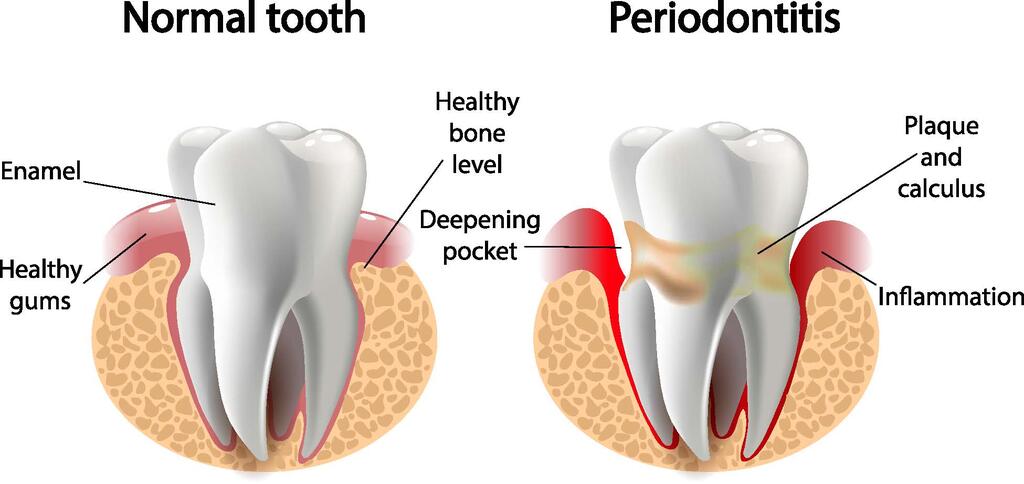Periodontal disease or gum disease as it it commonly known is caused by a buildup of plaque on the teeth and around the gums. This causes redness and swelling of the gums.
 A simple formula to help remember this is: PLAQUE + GUMS = GUM DISEASE
A simple formula to help remember this is: PLAQUE + GUMS = GUM DISEASE
The two most common periodontal diseases are:
Gingivitis – inflammation of the gum at the necks of the teeth, and
Periodontitis – inflammation affecting the bone and tissues of the teeth.
These are chronic, inflammatory diseases that affect 8 out of 10 people aged 35 years and over across Europe and are among the most widespread chronic disease conditions in Ireland. Most Irish adults suffer from some form of periodontal disease. Healthy gums should be pale pink in colour, have a matt surface and firm consistency, and their edges should be finely tapered. They should never bleed when probed by a dentist or during routine tooth brushing or flossing.
Gingivitis
Gingivitis is early gum disease and most children have signs of some inflammation of the gingival tissue at the necks of the teeth; among adults, the initial stage of gum disease is widespread. Signs of it are redness of the gum margins, swelling and bleeding of the gums on brushing. The good news is that gingivitis can be reversed by effective personal oral hygiene practices. Toothbrushing as part of daily grooming seems to have resulted in mouths being generally cleaner and showing less signs of inflammation, particularly among younger adults, though gingivitis is still widespread in the population.
Periodontitis
If gingivitis is not treated it may advance to periodontal disease, affecting the bone and supporting tissue, and is characterised by the formation of pockets or spaces between the tooth and gums and may progress to loosening or loss of teeth. The majority of adults are affected by gingivitis, do not always develop periodontal disease.
One of the challenges for early detection of periodontal disease is its “silent” nature – the disease does not cause pain and can progress unnoticed. In its early stages, bleeding gums during toothbrushing may be the only sign; as the disease advances and the gums deteriorate, the bleeding may stop and there may be no further obvious sign until the teeth start to feel loose. In most cases, periodontal disease responds to treatment and although the destruction is largely irreversible its progression can be halted.
As well as causing tooth loss, the bacteria causing periodontitis can enter your bloodstream through gum tissue, possibly affecting other parts of your body, for e.g. periodontitis is linked with pneumonia, rheumatoid arthritis, coronary heart disease and in controlling blood sugar in diabetes.
Signs of periodontitis include:
- Bad breath that won't go away.
- Red or swollen gums.
- Tender or bleeding gums.
- Painful chewing.
- Loose teeth.
- Sensitive Teeth.
- Receding gums or longer appearing teeth (hence the saying 'Long in the Tooth'!).
Make an appointment with your dentist or oral health professional if you think you have any of these signs. They can professionally remove plaque and hardened plaque (calculus). Early treatment of periodontitis can save affected teeth. If left untreated, gum diseases will worsen over time and can cause tooth loss, problems with chewing, speech and chronic bad breath. More great reasons to take care of your gums!
Factors Affecting Periodontal Disease
Gum disease is associated with cardiovascular disease, type 2 diabetes, chronic kidney disease and other serious chronic conditions. It increases with age and also as a result of contributing factors such as smoking and obesity. Diet also impacts on periodontal health, from both the perspective of plaque build-up and the body’s immunoinflammatory responses. Stress has been linked to periodontal disease, but it's not clear whether the relationship has a physiological basis or is due simply to the fact that individuals under stress are less likely to perform regular good oral hygiene. It is common for more severe forms of periodontal disease to present in individuals with compromised immune systems, e.g., those with diabetes, HIV infection, leukaemia and Down syndrome.
Plaque Control for Gingival Health
Plaque control is the most important method of limiting periodontal disease and maintaining gingival health. This must be considered at two levels: what you can do for yourself by way of plaque control on a daily basis, and what dentists and hygienists can do to eliminate plaque retention factors and to advise patients on the most appropriate home care.
What can we do to prevent gum disease? Effective daily plaque control is the answer:

The most important plaque control method is toothbrushing and this should be established as a daily routine from early childhood. Toothbrushing skills should be taught to people of all ages. It is important that plaque is removed effectively and daily without damage to the teeth or gums. The use of a toothpaste which contains fluoride will have the added benefit of helping to protect the tooth enamel from acid attack. Sometimes tooth cleaning can be difficult due to overhanging edges on fillings, poorly contoured fillings, and some types of partial denture designs, and encourage the accumulation of plaque. The presence of calculus (tartar) – plaque that has calcified and hardened – may also cause plaque to accumulate more readily and requires professional removal - scale and polish. For the majority of us periodontal health can be effectively maintained by proper oral hygiene practices as well as avoidance of tobacco smoke, stress, poor diet.
As periodontal disease is linked to an increased susceptibility to systemic disease (e.g., cardiovascular disease, infective endocarditis, bacterial pneumonia, low birth weight, diabetes) it is important to control periodontal disease for good oral health and general health.
Professional Treatment
It is the responsibility of the dental clinician to ensure that any dental treatment provided minimises plaque retention; this is a part of treatment planning. Clear advice must be given on the need to clean bridges, dentures and orthodontic appliances (braces) effectively and regularly. Calculus (or tartar) is a form of hardened (mineralised) plaque, which can form on teeth both above gum level and within periodontal pockets. Calculus cannot be removed by toothbrushing; careful professional scaling is needed for its removal. While appropriate professional treatment is important, it must be stressed that the highest priority for plaque control is effective daily oral hygiene by the individual.
Periodontal disease can be prevented with: daily meticulous removal of plaque by toothbrushing; regular visits to the dentist/hygienist (once a year) and avoidance of behavioural and environmental risk factors(e.g., smoking, stress, poor diet).